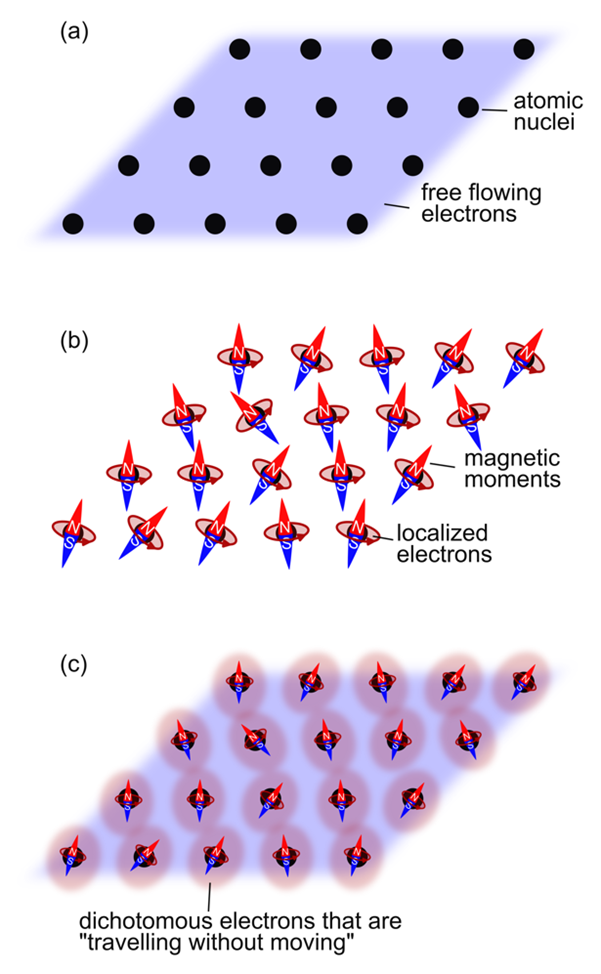Dichotomous Electrons: Travelling without Moving
In quantum materials, electrons may appear to be simultaneously in motion and stopped. Understanding such dichotomous electrons is crucial to exploit the full potential of quantum matter for future applications; yet, they are notoriously difficult to calculate and measure for real materials. Now, with the help of high-resolution experiments at the Swiss Spallation Neutron Source SINQ and the Oak Ridge National Laboratory Spallation Neutron Source, an international team has made a breakthrough on both fronts.
Even though mostly flying under the radar of most of us, how electrons flow and ebb in various types of materials has a daily and measurable impact on our lives. Understanding and controlling the motion of electrons is closely connected to the rapid advancement of our modern society, driving technologies ranging from switches and sensors to computers and smart devices, to the internet and cloud connectivity, to electrical cars and bikes, all the way to medical devices such as MRIs scanners. The seamless orchestration of electron behavior underpins the foundation of the technological landscape that shapes our contemporary world.
The role of free-flowing electrons in powering lights, heaters, household appliances, and nowadays many devices and gadgets in our homes is commonly recognized. What is less known is that electrons that cannot flow freely and are nearly stopped are equally crucial.
Electrons, when flowing through a conductor, generate a magnetic field. In order to harness this phenomenon for the construction of electric generators or motors, a permanent magnet is needed on which the magnetic field produced by flowing electrons can exert force. This is where "localized" electrons play a vital role: here, they become trapped by the positive charges of atomic nuclei comprising the permanent magnet. Orbiting around the nuclei, these localized electrons rise to the formation of magnetic moments—atomic-scale magnets—which align collectively to create a permanent magnet.
Quantum Stop & Go for New Applications
The story of localized and free-flowing electrons collaborating to create functionality is not new. Numerous materials, including the permanent magnet itself, showcase the coexistence of both types of electrons, harmoniously residing within a single material. “Surprisingly, it turns out that in certain quantum materials, electrons are neither completely free flowing nor completely stopped. In fact, they show both qualities at the same time. You could almost say they are travelling without moving, to quote Jamiroquai – one of my favorite artists,” says Marc Janoschek whose team, jointly funded by PSI and the University of Zurich, is working on the understanding of quantum materials.
Here, an extensive body of experimental and theoretical work has demonstrated that exotic and functional properties of quantum materials arise thanks to this electronic dichotomy. A well-known example is high-temperature superconductivity. In addition, there are many other quantum states that show interesting switchable properties that are not understood in detail. Wolfgang Simeth, lead author of the study and postdoctoral researcher in Janoschek’s group, points out that “it is clear that in order to use the potential of quantum materials to design future applications this electronic duality needs to be understood in detail, which was the aim of this project.”
The Kondo Lattice Model to the Rescue
One way to understand this electronic dichotomy is the Kondo lattice model. While this model has long been known to qualitatively capture the properties of a broad range of such quantum materials, it is notoriously hard to solve for real materials. At the same time, experiments are challenging as they require extremely high resolution to capture subtle effects arising from the underlying electronic complexity. This is where the study by Simeth and coauthors made a breakthrough.
Theory collaborators from the University of Tennessee, Los Alamos, and RIKEN calculated the electronic band structure for a real material. From this, they were able to derive the Kondo lattice model for this material, CeIn3, and calculate electronic and magnetic properties that could be quantitatively measured with advanced neutron scattering experiments at the Swiss Spallation Neutron Source SINQ and the Spallation Neutron Source at Oak Ridge National Laboratory in the United States.
“The high-resolution of our neutron spectrometers revealed details of electronic duality that have never been seen before,” says Simeth. In fact, the researchers believe that such details would be accessible in previously studied materials, but have been missed due to the lower resolution of neutron spectroscopy experiments. Filip Ronning from Los Alamos National Laboratory — a collaborator on this study and expert in studying quantum materials — adds: “This work provides a manual on how to derive and validate models that are needed to understand the novel quantum states arising from dual natured electrons.”
Text: Paul Scherrer Institute / Marc Janoschek and Miriam Arrell
